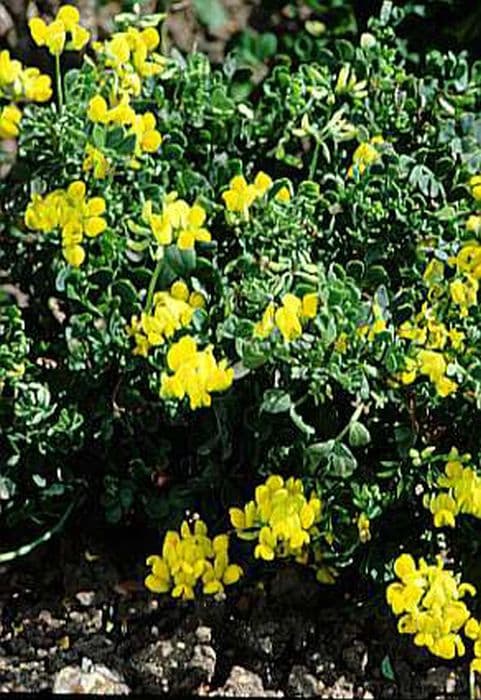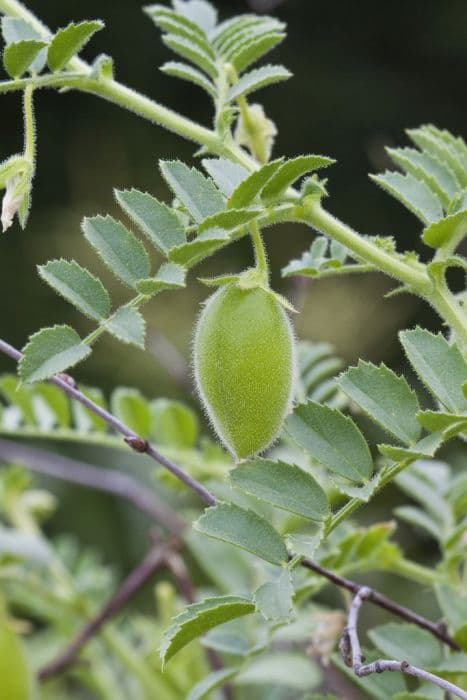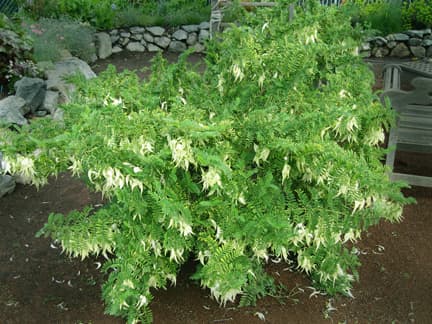White clover Trifolium repens 'Dragon's Blood'

ABOUT
Dragon's Blood is a unique cultivar known for its striking appearance. This plant is a type of white clover with rich, deep maroon leaves, which give it the name "Dragon's Blood." The leaves are trifoliate, meaning they are composed of three leaflets, which is a characteristic feature of clovers. Each leaflet is often heart-shaped, adding to the ornamental quality of the plant. The foliage can start with a green color but as the plant matures, or during stress conditions such as cooler temperatures, it transitions to the distinctive deep red or maroon shade. This coloration provides a dramatic contrast to the more common green hues found in lawns and gardens, making it a popular choice for adding visual interest. Moreover, Dragon's Blood produces small white flowers that may have a pink or red tinge. These flowers are typically arranged in globular clusters and add a delicate, decorative touch to the plant. The blooms not only contribute to the beauty of Dragon's Blood but also attract various pollinators to the garden. Overall, the plant presents a low-growing, mat-forming habit with the richly colored foliage providing a lush carpet effect. Its unique coloration and clover-like form make it a sought-after addition for gardeners looking to add ground cover with visual appeal.
About this plant
 Names
NamesFamily
Fabaceae.
Synonyms
White Clover, Dutch Clover, Ladino Clover, Dragon's Blood Clover.
Common names
Trifolium repens 'Dragon's Blood'.
 Toxicity
ToxicityTo humans
White clover, which includes the cultivar 'Dragon's Blood', is generally considered non-toxic to humans. This plant does not typically pose a risk of poisoning and is even edible in small quantities, such as being used as a garnish or in teas. However, although it is largely regarded as safe, some individuals might experience an allergic reaction or digestive discomfort if they consume large amounts of the plant or if they are particularly sensitive to it.
To pets
White clover, which includes the cultivar 'Dragon's Blood', is not known to be toxic to pets such as dogs and cats. It is not typically associated with poisoning in domestic animals. However, as with any non-food plant, consumption in large amounts may cause mild gastrointestinal upset such as vomiting or diarrhea due to the ingestion of non-digestible plant matter. Generally, pets will not experience severe symptoms from consuming this type of clover.
 Characteristics
CharacteristicsLife cycle
Perennials
Foliage type
Evergreen
Color of leaves
Green
Flower color
White
Height
6 inches (15 cm)
Spread
1 foot (30 cm)
Plant type
Creeper
Hardiness zones
4
Native area
Europe
Benefits
 General Benefits
General Benefits- Drought Tolerance: Dragon's Blood clover is relatively drought tolerant once established, requiring less watering.
- Erosion Control: Its dense mat-forming growth habit can help prevent soil erosion on slopes and banks.
- Lawn Alternative: It can be used as a low-maintenance ground cover instead of traditional grass lawns.
- Nitrogen Fixer: As a legume, it enriches the soil by fixing atmospheric nitrogen, reducing the need for synthetic fertilizers.
- Pollinator Friendly: Flowers attract bees and other beneficial insects, supporting biodiversity.
- Aesthetic Appeal: The unique red-tinged foliage and white flowers add ornamental value to gardens and landscapes.
- Low Maintenance: Requires minimal care once established, which can save time and resources on upkeep.
- Traffic Tolerant: Can tolerate moderate foot traffic, making it a robust choice for walkways and play areas.
- Adaptability: It can grow in a variety of soil types and pH levels, enhancing its versatility for different garden conditions.
- Feeds Livestock: Can be used as pasture for grazing animals, providing them with nutritious fodder.
 Medical Properties
Medical PropertiesThis plant is not used for medical purposes.
 Air-purifying Qualities
Air-purifying QualitiesThis plant is not specifically known for air purifying qualities.
 Other Uses
Other Uses- White clover, or Trifolium repens 'Dragon's Blood', can be used as a natural lawn alternative due to its ability to tolerate foot traffic and provide a lush, green ground cover.
- It can serve as a companion plant in vegetable gardens, as its presence can help boost soil fertility by fixing nitrogen from the air into the soil.
- White clover is often used in pasture mixes for livestock grazing, as it is a nutritious forage that promotes animal health.
- The plant can be used in the production of honey as white clover flowers attract bees and are a good nectar source for honey production.
- Crafted into floral arrangements or bouquets, white clover flowers provide a unique, whimsical addition and symbolize good luck.
- Leaves of white clover can be dried and used as a natural green dye for fabrics and yarns.
- Its deep root system can help prevent soil erosion, making it useful for planting in areas prone to losing topsoil.
- White clover is sometimes included in green roofing materials, thanks to its low-growing habit and minimal maintenance requirements.
- The flowering habit of white clover provides a habitat and food source for beneficial insects and wildlife, increasing biodiversity in gardens.
- Used in educational settings, white clover can be a model plant to study biological nitrogen fixation and plant biology in a classroom scenario.
Interesting Facts
 Feng Shui
Feng ShuiThe plant Clover is not used in Feng Shui practice.
 Zodiac Sign Compitability
Zodiac Sign CompitabilityThe plant Clover is not used in astrology practice.
 Plant Symbolism
Plant Symbolism- Luck: The most common name of Trifolium repens 'Dragon's Blood' is White Clover, and as a clover, it traditionally symbolizes luck, particularly when found in a four-leaf form.
- Promises: White clover also signifies promises and commitment, perhaps because clover patches create dense mats that represent interconnectedness and dependability.
- Fertility and Abundance: Due to its rapid growth and green color, white clover is also associated with fertility and the abundance of the natural world.
- Protection: The variety 'Dragon's Blood' has a red tinge to the leaves, which can symbolize protection and strength, possibly due to the visual association with blood and dragons being mythical protectors.
 Water
WaterWhite clover should be watered deeply but infrequently to encourage a strong root system; typically, water once every week or two, providing about 1 inch of water each time. During periods of extended drought, increase watering to once a week. When watering, soak the soil thoroughly to a depth of at least 6 inches. Gauge the amount of water used by placing a container on the ground to measure the output in ounces or gallons. Always allow the soil to dry out slightly between watering sessions to prevent overwatering and root rot.
 Light
LightWhite clover prefers full to partial sunlight, thriving best in bright environments. It should be planted in a spot where it can receive at least 4 to 6 hours of direct sunlight daily. Areas with morning sun and afternoon shade are ideal to protect the plant during the hottest part of the day.
 Temperature
TemperatureWhite clover does best in temperature ranges from 60°F to 85°F but can survive in temperatures as low as -20°F and as high as 100°F. It's important to provide a stable environment without extreme temperature fluctuations to maintain optimal growth.
 Pruning
PruningPruning white clover is not necessary for the plant's health but can be done to maintain a tidy appearance. Trim back any brown or damaged areas as needed, typically in late winter or early spring. Pruning also encourages denser growth and can rejuvenate an older planting.
 Cleaning
CleaningAs needed
 Soil
SoilWhite clover 'Dragon's Blood' thrives best in well-draining soil with a mixture of loam, sand, and compost. An ideal pH range for this plant is slightly acidic to neutral, between 6.0 and 7.0.
 Repotting
RepottingWhite clover 'Dragon's Blood' typically doesn't require frequent repotting and is often treated as an annual. If grown as a perennial, repotting every 2-3 years is adequate.
 Humidity & Misting
Humidity & MistingWhite clover 'Dragon's Blood' is adaptable to a wide range of humidity conditions and does well in average ambient humidity found outdoors.
 Suitable locations
Suitable locationsIndoor
Place in bright light, allow soil to dry slightly between waterings.
Outdoor
Plant in part sun, water regularly, and ensure good drainage.
Hardiness zone
4-9 USDA
 Life cycle
Life cycleWhite Clover 'Dragon's Blood' begins its life as a seed, which, under favorable conditions of moisture and temperature, will germinate and sprout. The seedling then develops a small rosette of leaves near the ground as it establishes a root system. It grows rapidly, producing creeping stems called stolons that root at nodes, leading to vegetative propagation and forming a mat-like ground cover. Flowering occurs in late spring to summer, displaying small, spherical flower heads that are pink to red, attracting pollinators for sexual reproduction. After pollination and fertilization, seeds are produced within the flowers, which then mature and are either dispersed by wind, water, or animals, or drop near the parent plant. In favorable conditions, the plant exhibits a perennial growth habit, surviving through seasons and capable of regrowing from stolons or crowns after winter dieback.
 Propogation
PropogationPropogation time
Spring-Early Summer
Trifolium repens 'Dragon's Blood', commonly known as the White Clover or Dragon's Blood Clover, is best propagated through seed sowing. The ideal time to sow White Clover seeds is in the spring, as soon as the risk of frost has passed, to give the seeds the best chance at germination and growth during the warm season. To propagate by seed, first prepare the soil by tilling and adding any necessary amendments to ensure good drainage and fertility. After soil preparation, disperse the small seeds evenly across the surface; this can be done by hand or with a seed spreader. Due to their size, the seeds should be only lightly covered with soil, if at all, as they require some light to germinate. Once seeded, the area should be kept consistently moist but not waterlogged until germination occurs, which should take place within two to three weeks under ideal conditions. Once established, White Clover will spread on its own, creating a dense ground cover.




![Kowhai [Sun King]](/_next/image?url=https%3A%2F%2Fplants-admin.emdemapps.com%2Fimages%2Fplants%2F%2Fimages%2F604b57cb7f598.png&w=640&q=75)




